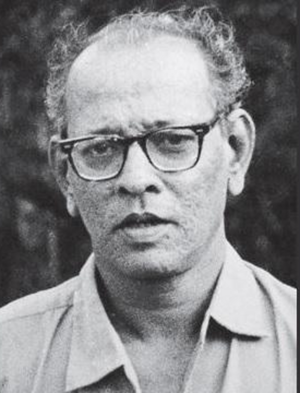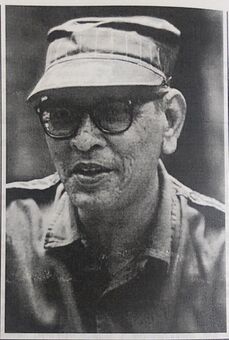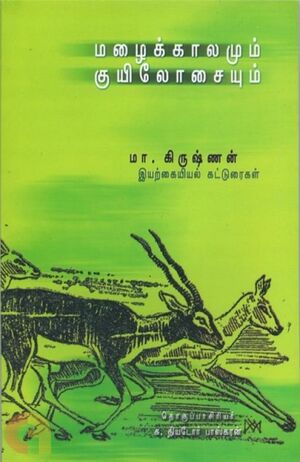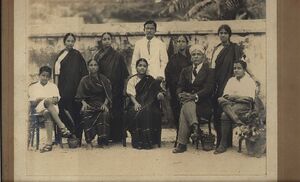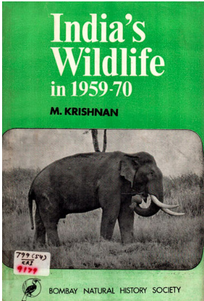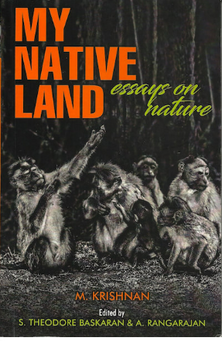M. Krishnan
இந்தப் பக்கத்தை தமிழில் வாசிக்க: மா. கிருஷ்ணன்
M. Krishnan (June 20, 1912 - February 18, 1996) is a writer and environmentalist. He was pioneer of environmental works in Tamil. M. Krishnan was responsible for the declaration of Vedanthangal as a bird sanctuary.
Birth, Education
M. Krishnan was born in Thachanallur, Thirunelveli to A. Madhaviah and Meenakshi on June 30, 1912 as the youngest of eight siblings. At the age of thirteen, his father A. Madhaviah passed away. He was taken care of by his elder sister Lakshmi. M. Krishnan has noted that his interest in nature sprouted at A. Madhaviah's house in Chennai which had a lush garden.
M. Krishnan completed his high school at Hindu Higher Secondary School, Chennai. He studied at The Presidency College, Madras from 1927 to 1933 and obtained a Bachelor's degree. Krishnan graduated in law from 1934 to 1936.
Personal Life
M. Krishnan married Indumati Hasabnis in 1937. They have a son named Harikrishnan.
M. Krishnan did not secure good marks in his law degree. So, it was difficult to find employment. After a brief apprenticeship in the court, he took on a job as Artist at Associated Printers. Then he worked as an Advertising Officer at the Madras School of Arts, Chennai. Later, he also worked for a short time as an Advertising Officer in All India Radio (AIR).
In 1938, his wife Indumati’s health deteriorated and doctors advised them to settle away from the city. Indumati's father lived in a place called Sandur, near Bellary, Karnataka. Upon his suggestion, M. Krishnan resigned his job at the All India Radio, settled in Sandur, and got a government post there in 1941. He worked in Sandur until 1950, beginning as a primary school teacher in the local school, moving on to serve as a judge and later as a publicity officer before finally becoming the political secretary to the Raja of Sandur. Later he moved back to Chennai and became a freelancer. M. Krishnan's son Harikrishnan is also interested in environmentalism.
Environmentalism
During his college days, M. Krishnan was inspired by Professor Philip Furley Fyson, Professor of Botany. M. Krishnan gained admiration for the birds when he accompanied Prof. Fyson in his travels to Nilgiris and Kodaikanal and learned the nuances of field research. He learned the art of watercolor painting from Diana Ruth Fyson, Philip Fyson's wife. While on a research trip to Kodaikanal with Fyson, M. Krishnan got an introduction to a renowned biologist Alfred Gibbs Bourne, and his wife Emily Tree Glaisher.
During his tenure at Sandur, Krishnan's hobby was wandering the dry forests of the region. His home had a large garden where he raised goats and dogs. Krishnan consistently recorded information about them. This was later useful for his writings.
After Sandur merged with the Indian union in 1950, M. Krishnan decided to let go of his government job and continue as a writer on his return to Chennai. He wrote ecological articles, stories, and articles on art, literature, and cricket in The Hindu daily newspaper, The Illustrated Weekly of India, and Shankar's weekly. His column, 'The Country Notebook', appeared in 'The Statesman' magazine and was released once every fortnight for forty-six years until he passed away.
M. Krishnan was one of the first scholars to receive the Jawaharlal Nehru Memorial Foundation Award in 1968-1970. He spent two years researching the Ecological Survey of the Mammals of Peninsular India. His study was published as a book on behalf of the Bombay Natural History Society, entitled India’s Wildlife (1959-70 (BNHS)).
M. Krishnan is a pioneer among Indian wildlife researchers. He has served on several committees set up by the Government of India for the protection of wildlife. M. Krishnan is also one of the founders of the 'National Board for Wildlife'. M. Krishnan traveled extensively in the 1960s. He visited and documented the Indian forests with the help of the government.
M. Krishnan wrote environmental books such as India's Wildlife’, Jungle and Backyard’, and 'Nights & Days: My Book of India's Wildlife’. He published an anthology titled Nature's Spokesperson M. Krishnan and Wildlife and Ramachandra Guha has written the foreword to this.
M. Krishnan opposed the cultivation of exotic trees in India. He opposed the growth of the Tabebuia tree in India which is a native of the American continent. He believed that "the identity of a country should rely more on its geography, flora and fauna and its natural foundations than depending on ever-changing human culture".
Photography
During the initial period of his life in Chennai, M. Krishnan struggled to live with the income only from writing. He learned photography as well as sketching. The early pictures taken from his camera (Super Ikonta by Zeiss-Ikon) became famous. He also learned to repair cameras. Till the end, M. Krishnan was inclined to take pictures in black and white. He was in the habit of filming using the 35 mm films. As its negatives were big, he thought by making it even large, the pictures would have more clarity. In 1966, Kodak organized an exhibition of wildlife photographs taken by M. Krishnan in Chennai.
Literary Life
M. Krishnan was a full-time writer for around fifty years. Ramachandra Guha quotes 'The count of articles written by M. Krishnan till he was alive was more than 2000' in his book on M. Krishnan. Only a small portion of that book is available now. M. Krishnan used the pen name 'Z' and wrote articles in The Hindu newspaper. M. Krishnan's letters to his granddaughter Asha Harikrishnan were compiled and published under the title 'Books of Beast'.
M. Krishnan wrote in Tamil magazines Manjari and Kalaimagal. He also wrote a novel called 'Kadiresan Chettiyarin Kaadhal'.
Rediscovery
M. Krishnan was over-looked in Tamil. His friend S. Theodore Baskaran, published a collection of M. Krishnan's essays after his death with the title 'Mazhaikaalamum Kuyilosaiyum'. This brought forth the attention of next generation readers in Tamil.
M. Krishnan's articles on birds were published in an encyclopedia published by the Chennai Tamil Development Corporation under the title 'Paravaikalum Vedanthangalum' (Birds and Vedanthangal) with Perumal Murugan as the editor.
Awards
- M. Krishnan was conferred the 'Padma Shri' award by the Indian government in 1970.
- M. Krishnan received the Global 500 Roll of Honor of the UNEP (United Nations Environment Program) in 1995.
Memorial Awards
Madras Naturalist Society presents the 'M. Krishnan Memorial Awards'[1]
Death
M. Krishnan passed away at the age of 84 on February 18, 1996.
Contribution
M. Krishnan is the primary reason for the declaration of Vedanthangal as a bird sanctuary. His directions were crucial in the formation of Mudumalai Sanctuary, Bandipur Sanctuary, and Jim Corbett National Park. M. Krishnan is one of the founders of the Chennai Snake Park in Chennai.
The simple and beautiful essays written by M. Krishnan kindled motivation amongst general readers to read more about ecology. He believed that instead of long research essays, short articles that speak directly to people produced the greatest effect. M. Krishnan is considered a pioneer in the ecological writing of India.
M. Krishnan had the practice to search and use Tamil names for birds, animals, and plant species in his Tamil articles. He said that the names of plants, animals, and ecological messages in a language are the treasures of that culture. And if they disappear, the ancient knowledge accumulated by the community would be destroyed. He also noted that translating words about nature directly from English is a kind of ecological destruction.
List of Books
- Kadiresan Chettiyarin Kaadhal (novel)
- My Book of India Wildlife
- Jungle and Backyard
- India's Wildlife night and days
- Books of Beast
- Paravaikalum Vedanthangalum
- Mazhaikaalamum Kuyilosaiyum (article)
Reference
- M. Krishnan's website
- Short Stories before Independence (1882-1947) : Selected Collections byAravind Swaminathan, Yaavarum Publishers, 2021
- M. Krishnan's Memorial Event, The Hindu
- Paravaikalum Vedanthangalum, omnibus
- M. Krishnan's Worlds by Ramachandra Guha, Nambi Krishnan in Tamil, Kanali
- Madras Naturalists' Society (Regd)
- A spokesman for Nature, The Hindu
Links
⨮ Standardised-en
Please do not write any content below this line. This section is only for editing templates & categories.
